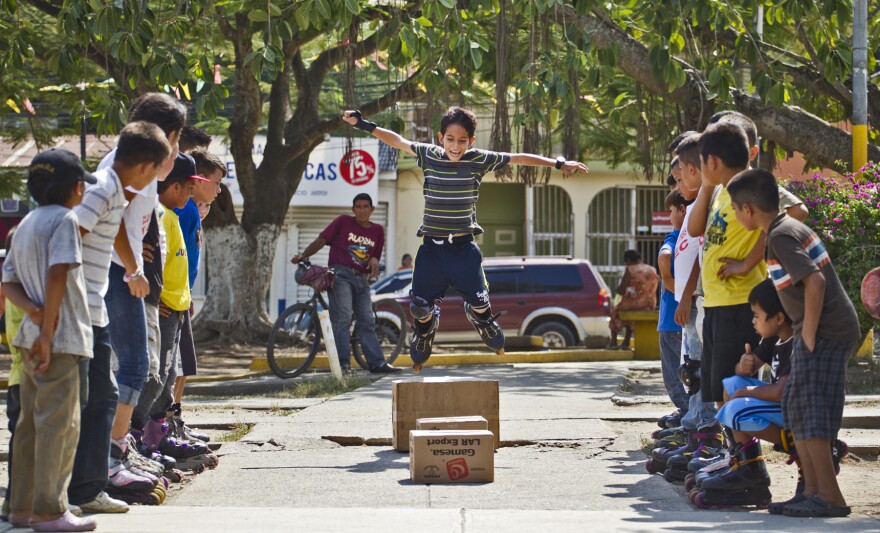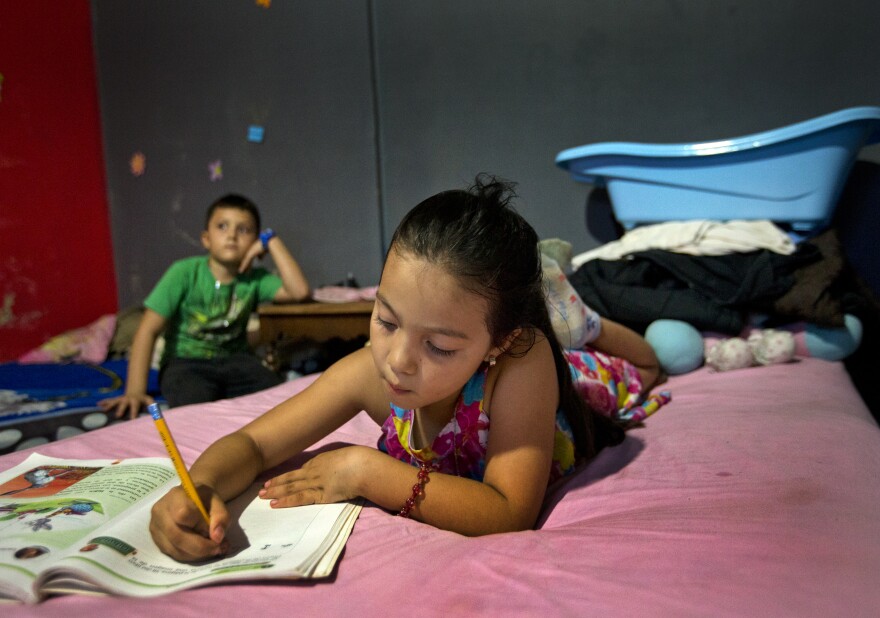Some U.S.-funded programs help would-be immigrants improve their lives and stay home.
TEGUCIGALPA | Here’s the first thing to know about Jessel Recinos: He’s a breathtaking rollerblader.
Almost every day, Recinos skates in Cofradía Park in San Pedro Sula, Honduras’ second-largest city. He spins, makes hairpin turns and takes soaring jumps, his long locks blowing like wind socks. Kids scream his name as if he were a Honduran sports icon.
Here’s the second thing to know about Recinos: He should probably be dead.
“These people come to kill me when I was 16 years old,” he recalls in halting English.
Eight years ago, Recinos got involved with one of Honduras’ maras — the vicious street gangs that rule whole districts of San Pedro Sula, which until recently had the highest murder rate of any city in the world. One day, a rival gang member hunted him down because he thought Recinos had stolen his cellphone.
“I run, and he shot me five times.”
Inside his parents’ house, Recinos holds up his X-ray. A ghostly white spot indicates where a bullet lodged just next to his heart. After being shot, he staggered into a storefront Evangelical church, where congregants rushed him to a hospital. They also gave him this advice:
“You need to change your life. And I said, ‘Yes, I promise.’”
So started Recinos’ new life as a mentor on skates. He runs a club called Skate Brothers. It teaches kids to skateboard, rollerblade — and stay clear of the maras.
He’s helped keep scores of at-risk Honduran youths in school — and away from the decision so many make to migrate to the United States.

Recinos has stayed in Honduras even though his migrant cousins keep urging him to join them in Miami.
“If I go to the United States, I don’t help people,” Recinos says. “My country needs help — help the little boys here.”
Recinos’ resolve has now caught the attention of Uncle Sam. The U.S. Agency for International Development (USAID) says it’s looking at ways to support his effort and others like it in Honduras.
James Nealon, the U.S. ambassador to Honduras, calls it part of a larger mission to improve the desperate poverty and violence that drive illegal immigration from Central America to the U.S. — immigration that reached crisis levels last year.
“We have to [help] make those communities safer,” Nealon says. “Identify the at-risk children, offer them economic opportunities, educational opportunities — offer them hope, so that they see their future here in Honduras and not elsewhere.”
The idea of confronting illegal immigration at its source instead of at the U.S. border is finally catching on in Washington. President Barack Obama is asking Congress for $1 billion in new aid for Central America — and the largest share, about 40 percent, would go to the socio-economic project Nealon describes.
That includes recently launched USAID job-training programs like METAS, which means “goals” in Spanish. METAS, in fact, just ushered former San Pedro Sula gang leader David Estrada into real employment.

Estrada founded his neighborhood’s unit of Honduras’ most powerful street gang, MS-13. (One of his fingers was once chewed up in a machete fight.) He left that life about a decade ago, but had no other skills.
“I felt trapped,” Estrada says. “It was either leave Honduras or stay here and go back to the gang. And probably get killed, because the maras are a lot more violent today. In my day, we didn’t have all those scary tattoos you see them wearing now.”
Estrada now supports his wife, 7-year-old daughter and newborn baby as a warehouse logistics manager.
In Honduras’ capital, Tegucigalpa, another former gang member — Jesús “Chuy” Lanza — has turned $1,000 in USAID seed money into a successful downtown hamburger business.
So successful that the Honduras Chamber of Commerce just awarded Lanza $5,000 as one of the country’s best new entrepreneurs.
After Lanza left his gang a few years ago — it was about to ask him to commit his first murder — he, too, planned to migrate to the United States because his former mara mates wanted to kill him as a traitor. And getting a job in the U.S., he says, “was maybe a way to finally make my parents proud of me.”
Now Lanza is using part of his prize to do something special for his mother, who stood by him through it all — and now stands beside him each day grilling his popular burgers.
“I got the gang tattoos erased from my body,” he says, pulling up his shirt and showing a dark smudge on his back — the last trace of them.
The U.S. aid challenge is more daunting in the slums looming on the steep hillsides above Tegucigalpa. Barrios like San Martín, which sits in the crossfire between the MS-13 and Honduras’ most violent gang, known simply as 18.
“Kids here aren’t just exposed to gang life in the streets,” says Emanuel Rodríguez, a Honduran who works with U.S. aid officials in San Martín. “They often see it inside their homes. This is something more affluent Hondurans know nothing about.”

That’s a reminder, in fact, of a big risk Obama runs with his Central America aid proposal — namely, letting the region’s shamelessly negligent elite off the hook for improving living conditions there.
In recent years, Honduran political and business leaders have gotten more involved. Still, few are aware that in San Martín the maras count kids as young as a boy named Jason — who is 14 but was 12 when he first joined a gang — among their foot soldiers. He’d already graduated to roughing up extortion victims when earlier this year “somebody shot at me,” he says. “It scared me.”
Jason sought safe haven at a new USAID youth outreach center in San Martín. Since then, he’s picked up some computer skills — and learned to play Beethoven’s "Ode to Joy" on a flute-like recorder.
It would be nice to include Jason as an immigration-prevention story. Problem is, his father died a couple months ago. His mother is an undocumented migrant living in Texas, and that’s where he says he’ll be headed soon.
But he’ll take the recorder with him — a reminder that if he gets sent back to Honduras, he'll at least have someplace else to go besides a gang.
For information about SkateBrothers, you can contact Jessel Recinos at: jesselskate@gmail.com

WLRN's reporting for Migration Marathon was made possible by MBAF.


